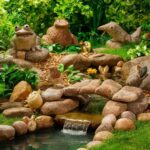Transform your outdoor space with these easy landscape ideas. Mulch your garden beds for weed control and soil health. Opt for sustainable hardscaping using durable materials. Embrace water conservation with xeriscaping and efficient irrigation. Consider low-maintenance groundcovers like clover and sedum. Harness native plants for water savings and biodiversity. Upcycle old items for unique landscape decor. Get creative with container planting using different sizes and materials. Illuminate your landscape with solar lighting for energy efficiency. These tips will help you revamp your outdoor area effectively.
Mulch for Garden Beds
Enhance your garden beds with the versatile benefits of mulch, a natural solution for improving soil health and reducing maintenance. Mulch serves as an organic barrier against weeds, reducing the need for constant weeding and upkeep in your garden beds. As it breaks down, organic mulch like wood chips enriches the soil with essential nutrients, promoting the overall well-being of your plants. Additionally, mulch helps regulate soil temperature, shielding delicate plant roots from extreme weather conditions, whether it be scorching heat or freezing cold.
Furthermore, mulch plays a crucial role in retaining soil moisture, decreasing the frequency of watering needed for your garden beds. By keeping the soil consistently moist, mulch aids in the healthy growth of plant roots and ensures your plants have access to the water they require. The aesthetic appeal of different mulch colors can also be utilized to complement your plantings, enhancing the visual allure of your garden beds.
Sustainable Hardscaping
Sustainable hardscaping involves incorporating durable materials like stones or pavers into outdoor structures to create long-lasting and environmentally-friendly landscaping features. When it comes to landscaping, hardscaping plays a crucial role in not just enhancing the visual appeal of your outdoor space but also in adding functionality.
Elements such as patios, decks, and retaining walls can be seamlessly integrated into your landscape design using sustainable hardscaping practices. By opting for stones and pavers, you’re choosing materials known for their resilience, low maintenance requirements, and ability to elevate outdoor areas.
These choices align with sustainable hardscaping strategies that focus on creating eco-friendly, durable, and visually appealing outdoor features. Embracing sustainable hardscaping not only reduces the environmental impact but also contributes to conserving valuable resources, making it a smart choice for both your property and the planet.
Water Conservation With Xeriscaping
When it comes to conserving water through xeriscaping, consider planting drought-resistant plants that require minimal watering once they’re established.
Mulching your garden can help retain moisture, reducing the need for frequent watering.
Additionally, incorporating efficient irrigation systems in your xeriscaping design can deliver water directly to plant roots, maximizing water conservation efforts.
Planting Drought-Resistant Plants
Planting drought-resistant plants through xeriscaping fosters water conservation practices and sustainability in landscaping design. Xeriscaping with drought-tolerant plants like Lavender, Succulents, and Yuccas can reduce water usage by up to 50% compared to traditional landscaping methods. These native plants require minimal watering once established, helping you save on maintenance costs by eliminating the need for frequent irrigation.
Mulching to Retain Moisture
Mulching plays a crucial role in retaining moisture in your landscaping design, aiding in water conservation efforts through xeriscaping. Here are some key benefits of using mulch for moisture retention:
- Reduce Water Evaporation: Organic mulches like wood chips or straw form a protective barrier that minimizes water evaporation from the soil.
- Prevent Runoff: Mulch helps prevent runoff by absorbing excess water, allowing it to infiltrate the soil slowly.
- Promote Healthy Root Systems: Proper mulching fosters healthy root systems by maintaining consistent soil moisture levels, optimizing water usage by plants.
- Enhance Water Conservation: By creating an environment conducive to plant growth, mulching supports xeriscaping principles and conserves water efficiently.
Efficient Irrigation Systems
To enhance water conservation efforts in your landscaping design, consider implementing efficient irrigation systems that complement xeriscaping principles. Xeriscaping, with its focus on drought-tolerant plants and sustainable landscaping practices, can significantly reduce outdoor water usage.
Utilizing efficient drip irrigation in xeriscaping not only promotes water savings but also supports the health of your plants. Drip lines and soaker hoses deliver water directly to the roots where it’s needed, cutting down on wastage and evaporation.
Low-Maintenance Groundcover Options
For a hassle-free and visually appealing groundcover solution, consider low-maintenance options like Creeping thyme that require minimal care and effectively suppress weeds. These options offer a range of benefits, from drought-tolerance to vibrant foliage colors, making them ideal choices for your landscape:
- Clover: Budget-friendly, drought-tolerant, and adaptable to various soil types, Clover provides lush green coverage while requiring minimal maintenance.
- Sedum: Known for its versatility, Sedum is a low-maintenance groundcover that thrives in drought conditions and displays attractive foliage colors, adding visual interest to your landscape.
- Sweet woodruff: Perfect for shaded areas, Sweet woodruff spreads quickly to form a dense mat of foliage adorned with small white flowers, creating a charming groundcover.
- Vinca: Also known as Periwinkle, Vinca is a popular choice with glossy green leaves and blue or purple flowers, thriving in different conditions and offering a visually appealing groundcover option.
These groundcovers not only enhance the aesthetic appeal of your landscape but also require minimal upkeep, making them an excellent choice for busy gardeners seeking low-maintenance solutions.
Native Plant Landscaping
When it comes to landscaping with native plants, you’re in for a treat. Native plants offer numerous benefits, such as attracting local wildlife and requiring less maintenance.
Designing with natives and following some simple maintenance tips can help you create a beautiful and sustainable landscape effortlessly.
Benefits of Native Plants
Leverage the benefits of native plants in your landscaping to enhance sustainability and reduce maintenance needs. Native plants are a great addition to your garden for several reasons:
- Water Conservation: Native plants are adapted to local conditions, requiring less water than non-native species.
- Biodiversity: These plants attract local wildlife, such as birds and butterflies, enhancing the variety of species in your garden.
- Environmental Sustainability: Using native plants helps preserve the local ecosystem and supports environmental sustainability.
- Cost Savings: By incorporating native plants, you can save on water usage and maintenance costs over time.
Make the most of these benefits by considering native plants for your landscaping needs.
Designing With Natives
To create a sustainable and eco-friendly landscape that supports local biodiversity, consider designing with native plants for your landscaping needs. Native plant landscaping involves using plants that naturally thrive in the local environment, promoting a healthy ecosystem. These plants are well-suited to the area’s climate, soil conditions, and wildlife, requiring less water and maintenance than non-native species. By choosing native plants, you contribute to the preservation of the local environment and provide a wildlife-friendly habitat. Check out the table below to see the benefits of incorporating native plants into your landscaping:
| Benefits of Native Plants | |
|---|---|
| Sustainable and Eco-friendly | |
| Supports Local Biodiversity | |
| Requires Less Water | |
| Low Maintenance | |
| Preserves Ecosystem |
Maintenance Tips for Natives
Consider incorporating these practical maintenance tips to ensure your native plant landscaping thrives sustainably and effortlessly.
- Reduce Irrigation Needs: Native plants require less water once established, reducing irrigation needs by up to 75% compared to non-native species.
- Attract Local Wildlife: Native plants attract local wildlife like birds and butterflies, contributing to a balanced ecosystem in your yard.
- Soil Health Benefits: Native plants are naturally adapted to the local climate and soil conditions, reducing the need for fertilizers and pesticides, improving soil health over time.
- Preserve Biodiversity: Using native plants in landscaping can help preserve biodiversity and support the survival of local plant species, while their deep root systems prevent soil erosion.
Upcycled Landscape Decor
Transforming old items into unique outdoor decorations enhances the charm and eco-friendliness of your landscape with upcycled decor. Upcycled landscape decor involves repurposing items like old tires, wooden pallets, barrels, and wheelbarrows for creative and eco-friendly outdoor decorations.
These upcycled items can be transformed into unique planters, garden art, seating elements, and storage solutions for a personalized touch to your landscape. By upcycling materials for landscaping decor, you can save money, reduce waste, and add character to your outdoor space with DIY projects.
Upcycling allows you to express your creativity and contribute to sustainability by giving new life to old items in your landscape design. Incorporating upcycled decor in your landscaping not only adds visual interest but also showcases your commitment to environmentally friendly practices.
Embrace the challenge of upcycling and enjoy the process of turning ordinary items into extraordinary landscape decorations that reflect your style and care for the environment.
Creative Container Planting
When exploring creative container planting for your landscape, think about the versatility and visual impact these arrangements can bring to your outdoor space. Here are some essential tips to ensure your container plants thrive:
- Choose the Right Containers: Select containers of various sizes and materials to suit different plant needs and aesthetic preferences.
- Ensure Proper Drainage: Proper drainage is crucial to prevent root rot; consider adding rocks or using containers with drainage holes.
- Monitor Watering and Fertilizing: Container plants may require more frequent watering and fertilizing than in-ground plants due to limited soil volume.
- Consider Sun Exposure and Space Constraints: Place your containers strategically based on the sunlight requirements of the plants and the available space in your landscape.
Solar Landscape Lighting
Solar landscape lighting offers a sustainable and practical way to illuminate outdoor spaces using natural sunlight. These energy-efficient lights not only save on electricity bills but also add beauty and functionality to the landscape. By strategically placing solar lights, you can highlight focal points like trees, pathways, or garden features, creating a visually appealing ambiance. The best part is that solar lights are easy to install – no wiring or electricity needed. Various designs are available, including path lights, spotlights, string lights, and decorative lanterns, allowing you to choose the perfect style to complement your landscape.
Moreover, solar landscape lighting serves a dual purpose by enhancing safety and security around the home. By illuminating pathways and dark areas, these lights help prevent accidents and deter potential intruders, providing peace of mind. Consider adding solar landscape lighting to your outdoor area for both functional and decorative purposes.
Frequently Asked Questions
How Do I Create a Beautiful Landscape on a Budget?
To create a beautiful landscape on a budget, start with DIY planters, creative borders, and thrift store finds. Use recycled materials for easy edging and simple pathways. Opt for low maintenance plants, budget-friendly flowers, and mulch solutions.
What Is the Cheapest Landscape Fill?
Gravel mulch is the cheapest landscape fill option. Wood chips, recycled materials, sand soil, and pea gravel are also affordable choices. Bark mulch, crushed stone, topsoil mix, and compost blend provide cost-effective alternatives for landscaping needs.
How to Fix up Your Yard on a Budget?
Revamp your yard on a budget by opting for budget-friendly plants, trying out easy DIY projects, incorporating upcycled decor, using low-cost mulching, hunting for thrift store finds, exploring creative edging, leveraging recycled materials, setting up simple irrigation, and installing affordable lighting.
What Is the Easiest Landscaping to Maintain?
For the easiest landscaping to maintain, opt for drought-resistant native plants in simple designs. With low maintenance and minimal upkeep, you’ll enjoy stress-free landscaping. Effortless gardening is possible with no-fuss strategies like mulch, rocks, and smart irrigation systems.
Conclusion
In conclusion, implementing easy landscape ideas can transform your outdoor space with minimal effort.
For example, by using sustainable hardscaping materials like permeable pavers, you can reduce water runoff and create a visually appealing patio or walkway.
Remember, small changes like mulching garden beds or incorporating native plants can make a big impact on the overall look and feel of your landscape.
So, roll up your sleeves and get started on creating a beautiful and eco-friendly outdoor oasis today!











